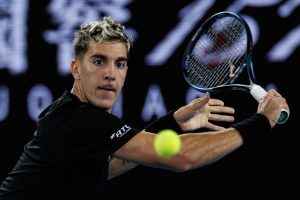It’s difficult to argue against – Arnya Sabalenka has had a fantastic season. Starting the season at world #10, Sabalenka put together many outstanding runs at some of the world’s biggest tournaments to finish her season ranked at #2. So, why does it feel as though Sabalenka was underwhelming at times this year? Could she have done better?
Aryna Sabalenka Season Review
First Grand Slam Semifinals
A lot had been said about Sabalenka’s inability to turn up at the Grand Slams. She held a poor 11-12 record in majors prior to this year, having gone 1-5 against seeded opponents. These woes continued at the Australian and French Opens, losses to Serena Williams and Anastasia Pavlyuchenkova further diminishing her seeded opponent record to 1-7 in Slams.
Then, all of a sudden, the floodgates opened to wins at the highest level and Sabalenka made it to two semifinals in quick succession. At Wimbledon, she beat Elena Rybakina and Ons Jabeur (who had beaten Garbine Muguruza and Iga Swiatek in the previous rounds) before falling in a closely contested match to Karolina Pliskova. Sabalenka followed this up at the US Open, making short work of an in-form Danielle Collins, Elise Mertens and the French Open champion, Barbora Krejcikova (more on what happened in her semifinal later…).
Aryna Sabalenka finally found a way to play like a world #2 at the Grand Slams, two semifinal appearances a deserved reward to her sometimes indomitable level of play.
Best Tournament of the Year
Speaking of an indomitable level of play, it’s important to acknowledge Sabalenka played some untouchable tennis at times this year. Though she was only able to win two tournaments this year, in Abu Dhabi and Madrid, she dropped only one set in both. She was incredible at both tournaments but, given the calibre of player she faced in Madrid, her run in the Spanish capital just outshines her level in the UAE. Therefore, given this was arguably her best tournament of the year, we’ll revisit some of her matches there.
- First three matches: Against Vera Zvonareva, Darya Kasatkina and Jessica Pegula, Sabalenka dropped only 12 games. All three players are quick around the court but, without punchy serves, Sabalenka was merciless against them on return winning over 50% of her return games.
- Quarterfinal: In her next two matches, Sabalenka continued her unstoppable form. Though Elise Mertens may have been injured in their quarterfinal, there seemed to be little she could have done fully fit as Sabalenka crushed every return she got. Mertens retired 1-6 0-4 down.
- Semifinal: Anastasia Pavlyuchenkova had beaten four top-25 players in a row – Sabalenka should have been up against it, yet, she was ruthless on break points, managing to tame the Russian’s fairly hefty serve. The most impressive thing in this win, however, was in her ability to neutralise Pavlyuchenkova’s normally stunning returns, finding insane power from both wings on her serve+1 shot.
- Final: This was Sabalenka’s match of the season. Against Ash Barty, Sabalenka came out firing, bagelling the world #1 in the first set – Barty fought back by slowing down the play and spot serving, however, in the second set. Sabalenka stayed strong in the toughest moments in the deciding set, her most headstrong performance of the season, to clinch an epic final in Madrid.
When Sabalenka is feeling the conditions, it takes a monumental effort to stop her. She was cutthroat on return and her serve packed enough punch to make her following shot nye untouchable.
Unravelling In Tighter Matches
Unfortunately, runs of form like this were the exception rather than the rule.
Some of the stats from the world #2’s season may surprise you at first glance.
- Sabalenka went 10-14 in deciding sets (for comparison, Barty is 14-3 this year).
- Sabalenka went 4-5 against top-10 players.
There was a recurring theme that blotched Sabalenka’s season.
- In the French Open third round, Sabalenka was bagelled in the deciding set against Pavlyuchenkova, a player she had been great against in Madrid. Her forehand deserted her – Sabalenka lost the plot, throwing her racket, and she wasn’t able to piece together her game again.
- In Montreal, Sabalenka lost fairly handily in the semifinals to Pliskova, a player she’d went toe-to-toe with at Wimbledon. Again, her groundstrokes went AWOL and she gifted too many free points in what could have been an exciting match.
- In the US Open semifinals, Sabalenka lost to Leylah Fernandez, the world #73 who had been on a tear all tournament. Losing in and of itself wasn’t the problem – it was at the tail end of the first and third sets, when Sabalenka’s game completely deserted her, that the problem lay. A terribly struck overhead comes to mind in the first set, one where her feet failed to move into position, and a few nervy double faults unforgettably littered the end of the match.
In matches where the pressure mounted this season, Sabalenka couldn’t seem to find that extra gear or she crumbled under the pressure.
Potential For More?
Sabalenka did have a fantastic season by all accounts – two Grand Slam semifinals and a Masters title are not too be scoffed at. But Sabalenka fans will surely be left feeling short-changed. After watching her in Madrid, dispatching the world #1 with steely resolve, it looked as though Sabalenka couldn’t be stopped at her best – as the season drew to a close, however, it became clear that Sabalenka was still having issues in the tighter moments of matches, 14 of her 18 losses coming in a deciding set.
The potential is there for Sabalenka to achieve greatness (Wimbledon was about as close as we got this season). Sabalenka should be proud of herself in 2021 but – undoubtedly – she shouldn’t rest on her laurels going into 2022. Sabalenka’s next steps are to find her best when it matters most.
Main photo:
Embed from Getty Images






